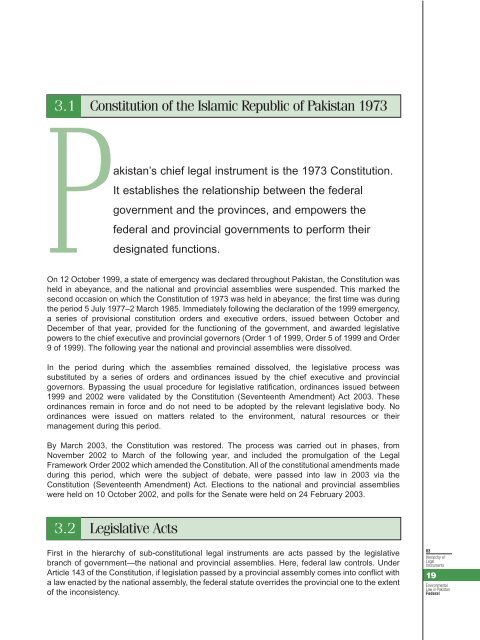Environmental Law in Pakistan - IUCN
Environmental Law in Pakistan - IUCN
Environmental Law in Pakistan - IUCN
Create successful ePaper yourself
Turn your PDF publications into a flip-book with our unique Google optimized e-Paper software.
3.1 Constitution of the Islamic Republic of <strong>Pakistan</strong> 1973<strong>Pakistan</strong>’s chief legal <strong>in</strong>strument is the 1973 Constitution.It establishes the relationship between the federalgovernment and the prov<strong>in</strong>ces, and empowers thefederal and prov<strong>in</strong>cial governments to perform theirdesignated functions.On 12 October 1999, a state of emergency was declared throughout <strong>Pakistan</strong>, the Constitution washeld <strong>in</strong> abeyance, and the national and prov<strong>in</strong>cial assemblies were suspended. This marked thesecond occasion on which the Constitution of 1973 was held <strong>in</strong> abeyance; the first time was dur<strong>in</strong>gthe period 5 July 1977–2 March 1985. Immediately follow<strong>in</strong>g the declaration of the 1999 emergency,a series of provisional constitution orders and executive orders, issued between October andDecember of that year, provided for the function<strong>in</strong>g of the government, and awarded legislativepowers to the chief executive and prov<strong>in</strong>cial governors (Order 1 of 1999, Order 5 of 1999 and Order9 of 1999). The follow<strong>in</strong>g year the national and prov<strong>in</strong>cial assemblies were dissolved.In the period dur<strong>in</strong>g which the assemblies rema<strong>in</strong>ed dissolved, the legislative process wassubstituted by a series of orders and ord<strong>in</strong>ances issued by the chief executive and prov<strong>in</strong>cialgovernors. Bypass<strong>in</strong>g the usual procedure for legislative ratification, ord<strong>in</strong>ances issued between1999 and 2002 were validated by the Constitution (Seventeenth Amendment) Act 2003. Theseord<strong>in</strong>ances rema<strong>in</strong> <strong>in</strong> force and do not need to be adopted by the relevant legislative body. Noord<strong>in</strong>ances were issued on matters related to the environment, natural resources or theirmanagement dur<strong>in</strong>g this period.By March 2003, the Constitution was restored. The process was carried out <strong>in</strong> phases, fromNovember 2002 to March of the follow<strong>in</strong>g year, and <strong>in</strong>cluded the promulgation of the LegalFramework Order 2002 which amended the Constitution. All of the constitutional amendments madedur<strong>in</strong>g this period, which were the subject of debate, were passed <strong>in</strong>to law <strong>in</strong> 2003 via theConstitution (Seventeenth Amendment) Act. Elections to the national and prov<strong>in</strong>cial assemblieswere held on 10 October 2002, and polls for the Senate were held on 24 February 2003.3.2 Legislative ActsFirst <strong>in</strong> the hierarchy of sub-constitutional legal <strong>in</strong>struments are acts passed by the legislativebranch of government—the national and prov<strong>in</strong>cial assemblies. Here, federal law controls. UnderArticle 143 of the Constitution, if legislation passed by a prov<strong>in</strong>cial assembly comes <strong>in</strong>to conflict witha law enacted by the national assembly, the federal statute overrides the prov<strong>in</strong>cial one to the extentof the <strong>in</strong>consistency.03Hierarchy ofLegalInstruments19<strong>Environmental</strong><strong>Law</strong> <strong>in</strong> <strong>Pakistan</strong>Federal
















